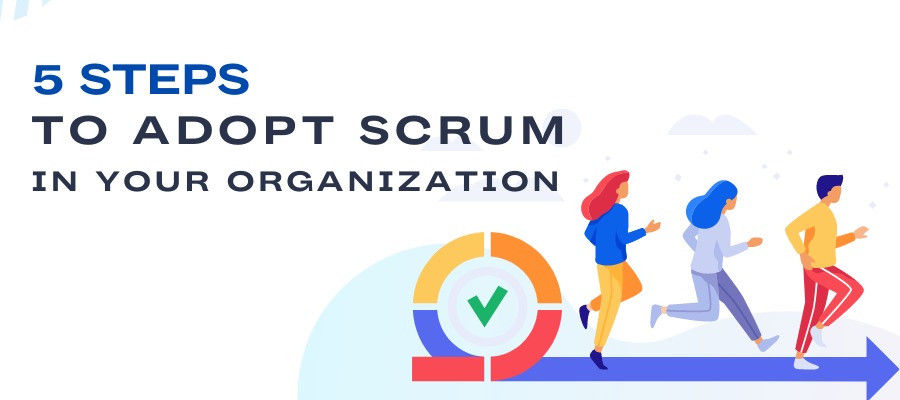5 steps to Adopt Scrum in your Organization

Scrum, a relatively new Agile framework, helps Agile Teams structure and manage their work responsibilities through Agile principles and practices. This Agile project management framework prioritizes self-organizing and cross-functional teamwork to help organizations reach their desired business goals. Many organizations still need to catch up on the effectiveness of Agile Scrum. Let’s explore how to adopt Scrum to bring the ultimate organizational-level Agile Transformation!
Why Must Organizations Adopt Scrum?
Scrum Framework offers an ideal project management platform for organizations that incorporates agility and flexibility. Scrum emphasizes self-organizing teams and encourages organizations to accept the flat hierarchy model where everyone contributes equally. The Scrum Team contains a dedicated Product Owner, Scrum Master, Business Analysts, Developers, Software Testers, UI Designers, and DevOps Engineers. So what exactly is the benefit of adopting Scrum, then? Here are the following reasons to opt for Scrum Framework:
- Upsurge the business value of the project deliverables
- Manage and plan the Product Goal for the teams
- Make improved estimates along with capacity planning
- Control the workflow based on the project’s schedule
- Encourage decision-making among self-organizing teams
However, most organizations fail to implement ‘Scrum’ properly. Instead, they claim to be ‘doing Scrum’ even when it doesn’t match the actual Scrum definition.
Essential Steps To Adopt Scrum Successfully:
Here are the five primary steps you must follow to help your organization implement Scrum successfully.
1. Perform Sprint Planning Based On The Product Goal
Generally, the Product Owner sets up the Product Goal, and the Scrum Team agrees to meet the product goal by the end of a certain number of sprints. Sprint is a time-boxed short period when the Scrum Team works to finish a fixed amount of work based on the Product Goal. Primarily, the Scrum Master performs Sprint Planning alongside the Scrum Team.
Each Sprint has a specific length, like one week, two weeks, or more, based on the Sprint Goal. During Sprint Planning, the Scrum Team discusses the next Sprint goal for the upcoming Production Release. The ultimate aim is to meet the Product Goal before the deadline. Effectively, the Scrum Team manages the Sprint Goal without overcommitting the project deliverables. It ensures the development and testing happen on time as per the ultimate Product Goal.
2. Manage The Product Backlog
Handling Product Backlog is a vital step for implementing Scrum successfully. The Product Owner creates the Product Backlog containing Epics, User Stories, Features, and more. Now, it’s up to the Scrum Team to manage the Product Backlog based on Sprint Planning. The Scrum Team actively assigns Story Points to each Product Backlog Item (PBI). Next, they choose specific PBIs to commit for the coming Sprint.
The Scrum Team can perform Product Backlog Refinement and split PBIs into smaller Work Items. With time, the Product Backlog keeps changing. So the Scrum Master must ensure that every PBI is up-to-date with accurate information. For that, the Scrum Master performs backlog reviews constantly. It helps to keep the Product Backlog short and achievable.
3. Maintain Clear Transparency
As Scrum encourages cross-functionality among Agile Teams, every team member should have clear visibility of the Product Backlogs. It doesn’t matter what roles and responsibilities the team members have. Everyone is equally responsible for managing and updating PBIs.
Agile Teams can perform better with clear transparency about the stakeholder requirements, end-user feedback, and business needs. So the Scrum Master must encourage the teams to update their Sprint Backlog Items daily. Once it becomes a habit, Scrum implementation becomes easier for the organization.
4. Monitor Work Progress
Often the Scrum Team fails to meet the Sprint Goal even after consistent Sprint Planning. That is why the Scrum Master must conduct Daily Scrum with the Developers to check the daily work progress and find potential blockers. The Scrum Master can also design and use a daily burndown chart to track the team's capacity and members’ day-to-day progress. With everyone updating about their activities, it becomes easier to estimate the expected delivery time.
5. Conduct Agile Training
Many organizational professionals don’t have proper training in Scrum as it is a comparatively new Agile Framework. Hence, every Scrum team requires an Agile Coach who can conduct Workshops and train professionals about various Agile Best Practices.
Learning Agile Methodologies like Scrum, XP, Kanban, etc., will help the Scrum Team develop a good understanding of Agile Scrum. They can participate in Scrum Retrospective sessions to discuss their Agile Learning journey.
Conclusion
Now you know how Scrum can bring Agile Transformation in organizations and improve cross-functionality among Agile Teams. Still, you have a long way to go to complete your journey as a CSM or CSPO. PremierAgile brings you top-quality learning programs to help you achieve the certifications faster. Make good use of your time and keep exploring different ways to adopt Scrum at an organizational level.
Reference
- Don’t confuse Scrum with “An Implementation of Scrum” | Scrum.org



